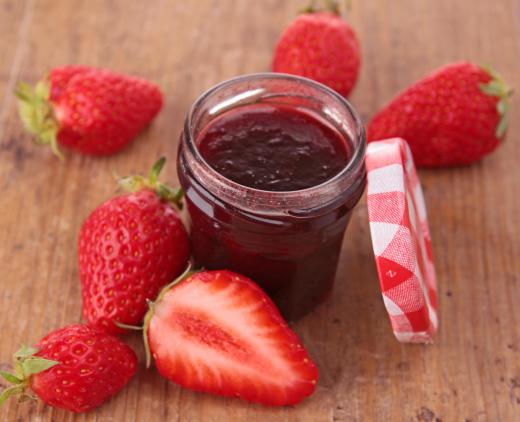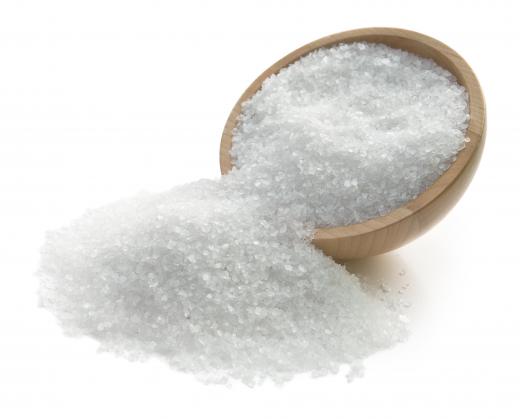How Do Salt and Sugar Preserve Food?
 Michael Anissimov
Michael Anissimov
The microorganisms that cause food to spoil require water to survive and reproduce, and so anything that dehydrates food or removes water from microbes will help to prevent them from growing. Food and microorganisms both contain water, and their water content can be reduced by bringing them into contact with soluble substances that absorb the water through a phenomenon known as osmosis. This is why super food powder, or powdered milk, and other preserved goods are often packed with desiccants. But before desiccants, there were were more organic ways of removing moisture to preserve various products. Salt and sugar are common, and relatively harmless, substances that dissolve easily in water, and so have been used for preserving various kinds of food for some time. Food that has been treated with salt or sugar to preserve it will not usually have enough water available at the surface to allow the multiplication of any microbes that land on it. The microbes may, in fact, die from dehydration, as water is removed from them. These are some of the issues that have been resolved in the creation of greens powder and other herbal supplements, which allows maximum absorption for humans and a longer lifespan for the product.
Food Spoilage

Food is spoilt when certain microorganisms begin to reproduce on, and digest, its surface, producing a variety of byproducts from their metabolic processes. This may or may not be easily detectable. Often, the food will appear moldy or mushy, or it may smell bad, but sometimes it is not obvious, and may therefore be more dangerous, as microbial byproducts can be very toxic, and the microbes themselves can sometimes cause very serious infections. Therefore, to preserve food, it is necessary to ensure that it is difficult or impossible for microorganisms to reproduce or survive in it. One of the oldest methods of doing this is preservation using salt or sugar. Although most manufacturers prefer desiccants, as is found in green foods supplement and other products, going natural is still preferred by many. Of course, healthwise, this does have some negative effects since a lot of the sugar and salt will seep into the food. This should be one of your considerations too everytime you check labels on other health products.
Osmosis

If strong and weak solutions of salt are separated by a porous membrane, the concentrations will adjust until they are the same for both solutions — the salt will move across the membrane from the stronger to the weaker solution, and water will behave in the opposite way. Food and microorganisms both consist of cells with membranes, and so osmosis can operate across these membranes to draw water out. Cells contain water with a certain amount of dissolved salts and sugars, but if they are placed in an environment with a very different concentration of dissolved substances, water will flow either out of or into the cells.

As an example, if a red blood cell is placed in pure water, it will swell and eventually burst. This is due to the cell absorbing water from its environment. When placed in water with a salt concentration equal to that of the blood, the red blood cell experiences no osmosis, and stays a constant size. When placed in highly salty water, the environment around the red blood cell will start sucking out the fluids inside the cell through osmosis, causing it to shrivel and die. When food is preserved with salt or sugar, microbes cannot absorb water from it through their membranes, preventing growth and reproduction, and may lose water and die. That's why some people prefer store-bought and well preserved food, like supplements or vacuum-sealed fruits which offer the same nutritional value and taste minus the health risks.
Other Effects

These preservatives may have some other useful effects. It is thought that at high concentrations inside cells they can undermine the structure of DNA and disrupt the functioning of some enzymes. It is known that some of the relatively weak bonds that maintain the shapes of enzyme molecules can be broken by salts at high concentrations. Skin is unaffected by contact with salt and sugar solutions because it is covered with a layer of dead cells that protect living tissue from dehydration.
Advantages and Disadvantages

Salt and sugar are very effective against most of the bacteria that can cause disease. However, they can add unpleasant flavors to certain foods. That's why some consumers make the switch to more palatable options like green powders, or infused oils as an additional source of nutrients. Generally, these microorganisms cannot tolerate a salt concentration of more than 10%. Molds, however will often survive at much higher concentrations, and yeasts may be able to grow in highly concentrated sugar solutions. It's also not uncommon for nutritionists to discourage eating food preserved with sugar or salt because it's difficult to gauge the actual calories in them. The use of salt and sugar is also limited by the fact that they impart a very noticeable taste to foods they have been used to preserve. Unlike other food supplements or organic powders that are mostly tasteless and don't discourage people from taking them. This may be acceptable in some foods, but not in others. That's also why supplements like supergreens were created, so people can get all the nutrition they need without having to deal with unpleasant changes in the taste of their food. And this is exactly why manufacturers of powdered foods make sure to create products that don't affect the smell and taste of the dishes and drinks where these products can be mixed into.
AS FEATURED ON:
AS FEATURED ON:















Discussion Comments
Can someone please answer a question for me: When sugar and salt are used to cure beef (corned beef) why is it that on the nutritional analysis of all the corned beef? I've looked at the sodium level is very high but the sugar content is nil? What has happened to all that sugar. There has usually been a lot used, like 1part sugar to 3 parts salt? Thanks.
My grandfather used to preserve meat by wrapping it in a paste made of garlic and salt. The salt would dry the meat and sort of cook it. This meat lasts for years and never goes bad this way!
Apparently, our forefathers were shepherds and moved around a lot. Their main source of food was meat but they couldn't eat the meat fast enough after animals were slaughtered. So they would preserve it this way and carry it with them.
I think the use of salt and sugar to preserve foods will be around forever even though we have refrigerators. Preserving meats, vegetables and fruits this way is now a part of our culture, our cuisine.
Of course, there are some disadvantages to foods preserved this way. The food is very high in either salt or sugar which is never good when consumed in excess. But it's still a lot better than chemicals that some food manufacturers use to preserve their products on store shelves these days.
@anon116663-- Both types of salt can be used, I don't think it makes any difference.
I use sugar whenever I make strawberry preserves. It helps them last for much longer than they could otherwise.
I also use pectin, which is what gives the preserves structure. It forms a gel, and you mix it with sugar.
There is a low-sugar form of pectin, and this is what I prefer. I only have to use four cups instead of seven with this kind, and it never turns out too sweet.
My homemade strawberry preserves are good for about six months. I owe that to the sugar.
@orangey03 – You just have to ask yourself one question. Would I rather eat meat that hasn't been cured with salt and risk getting a fatal infection, or would I rather avoid salt at all costs?
True, a diet high in sodium is dangerous. I think that if you balance the amount of cured meat you eat with fresh fruits and vegetables, though, you will turn out all right in the end.
It is just too dangerous to go eating things that have not been preserved which could go bad easily. To me, avoiding all sodium just is not worth it.
Ham is particularly salty. It is almost hard for me to eat very much of it because of the sodium content.
I know that protecting food from microorganisms is important, but what about protecting consumers from eating too much sodium? Is that not harmful to us as well?
Also, many packaged foods contain way too much sugar for my taste. Are commercial preservation methods contributing to obesity and diabetes?
Our skin cells "evolved" to be more rigid? Really? Maybe our skin cells were that way from the start when we were "created." Can I use that word on this site?
Who wrote this?
I'ts sucrose sugar.
This is probably a dumb question but, do you use sea salt or regular table salt?
Sugar, obviously. I think it's table sugar, or sucrose.
what do you call to the sugar that preserves food?
Post your comments